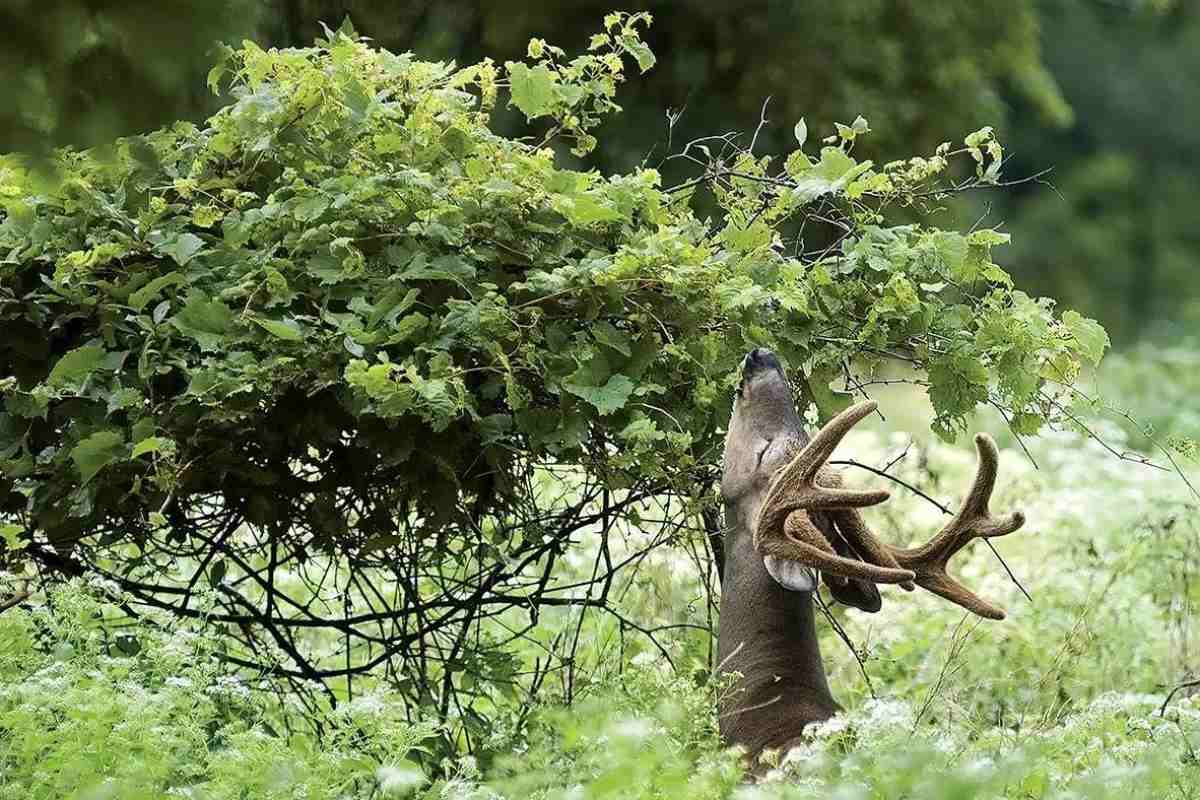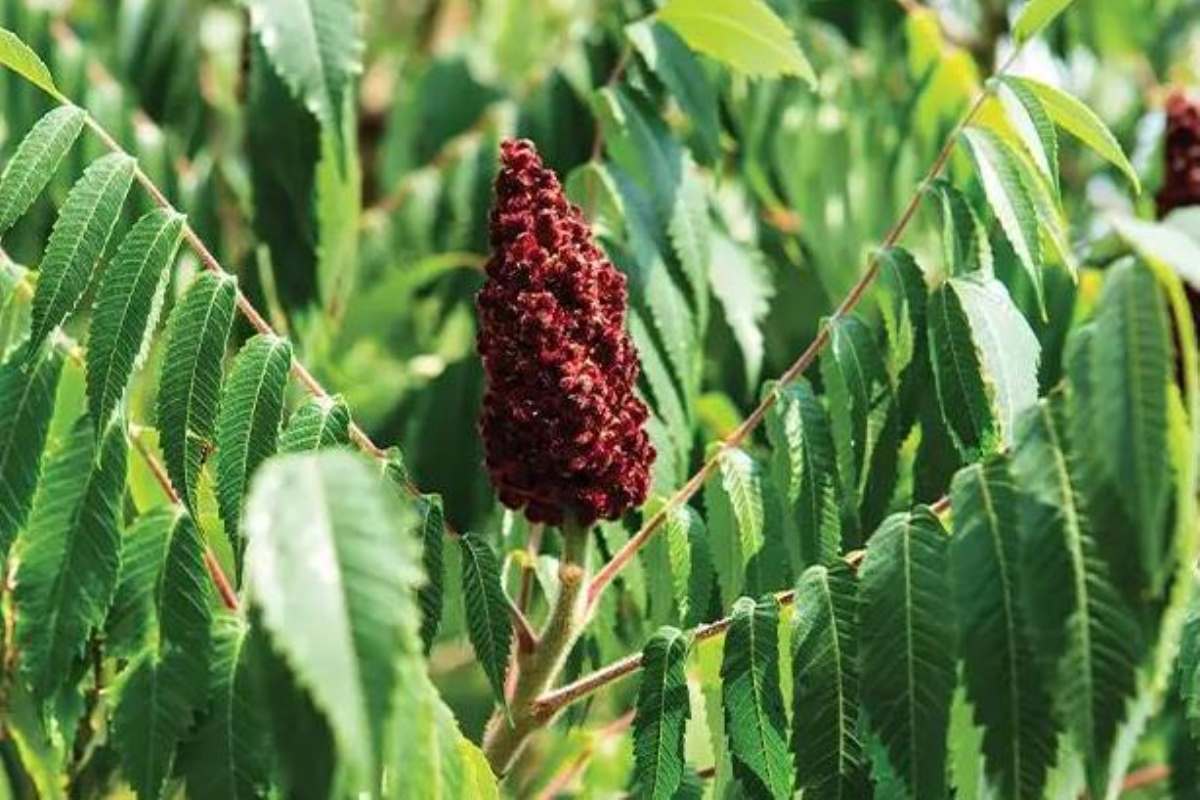
(Photo courtesy of North American Whitetail Magazine)
Managing whitetail habitat involves laying out all the elements of the whitetail landscape in the correct location and quantity. I spent some 26 years studying the spatial requirements of whitetails, concluding the basic management unit includes around 80 acres in the eastern U.S. and 160-plus acres in the west.
Within this area, the optimum mix includes natural forage, hard and soft mast, thermal cover (warm and cool seasons), screening cover, travel corridors, sanctuaries, and water. My research showed that the optimum percentages of these elements are 30-40 percent of the landscape in forage, 20 in mast, 20 in cover, and the remainder in travel corridors and sanctuary/bedding areas. Each unit should also have at least one permanent water source.
Of course, some of these serve more than one purpose, so there is overlap. Also, we can add supplemental forage in the form of food plots where rainfall meets or exceeds 30 inches annually, which should be between 3-10 percent of the land, depending on the habitat.

Whitetails have a very broad spectrum of food preferences, including browse (leaves and twigs of woody plants), weeds (forbs), mast (nuts and fruits), mushrooms and a small percentage of young grasses. Deer are not cows, and they are not very good at digesting highly fibrous mature grasses. As a matter of fact, they lack the diversity of “bugs” we find in cattle stomachs to digest these plants.
Also, cattle-like animals have very broad mouths and tongues, and they just move about “hoovering” up ground-level vegetation. Deer, on the other hand, have pointed snouts and a long tongue, and move about the landscape picking the best parts of plants with high digestibility.
SHRUBS AS BROWSE
I write whitetail and wildlife management plans for dozens of landowners each year, and it is something I really enjoy! No two properties are alike, and deer habitat management is site-specific. Each property has its unique opportunities and challenges when improving the life of whitetails.
I always begin the plan with a detailed analysis of the deer landscape, identifying areas that can satisfy the above life requisites. The “backbone” of the plan is how and where to produce a sustainable supply of highly nutritious vegetation in the “deer zone,” the area that lies from ground level to 4.5 feet. Everything a deer eats must be within this zone, including the acorns that fall into it.
Sustaining the quality of vegetation within the deer zone is difficult due to succession, the process in which plant communities progress over time from an area covered by short weeds and grasses to shrubs and young trees. Those shrubs and small trees lead to tall, mature trees that shade out the vegetation within the deer zone.
Deer would prefer to eat forbs since they are easily digestible and full of energy and protein. Unfortunately, forbs don’t last very long, due to susceptibility to cold and a lack of rainfall. The annual cycle sees forbs flourish in the early spring, then mature and flower over the summer and fall. During droughts, they disappear altogether, so you really cannot depend on them in a sound whitetail nutrition program. That means browse is the real mainstay for deer; it’s the one thing they can depend on.

Note that I said above that browse is defined as the leaves and twigs of woody plants. The leaves are certainly more nutritious than stems, but the twigs are still available during those harsh times! Browse consists of both shrubs and young trees, but the trees grow above the deer zone, so they are only useful during the early stages of succession.
Shrubs, however, are small-to-medium-sized perennial woody plants, that can be deciduous or evergreen. The growth habit includes multiple stems, which can be produced during a short portion of the growing season or continuously in response to rain. The most commonly used terms for this are determinant and indeterminant. New growth is always the most digestible and nutritious.
Deer have definite preferences for browse plants, which is most often influenced by digestibility. My friend and colleague, Dan Lay, was the first to quantify a whitetail’s preferred forage as first, second, third, and emergency-choice species. Plants have spent millions of years “fighting a war” with herbivores to keep from being eaten. They have devised a host of defenses, including thorns, bad-tasting chemicals, and poor digestibility. The waxy coating on many shrubs’ leaves is there to deter browsing and reduce loss of water.
Only a few plants are classified as first-choice, leaving deer to subsist mostly on second-choice species. The table presents some of these, along with those that deer will not eat unless they are starving. My research showed that the first-choice species make up less than 5 percent of the browse plants in most of the whitetail range. We will return to this fact a bit later.
Shrubs offer two kinds of food to deer: vegetative matter and fruits. Vegetative matter, which includes stems, is available throughout the growing season. Fruits generally appear during a very short period in spring or fall. The 30-40 percent of the basic whitetail management unit recommended for forage production mostly consists of browse plants interspersed with weeds. In many areas, first-choice (and even many second-choice) browse plants have become rare or even non-existent.
A few years ago, we developed a Build Your Own Deer Factory series on a property in Illinois for NAW TV. To my surprise, no first-choice and very few second-choice browse plants were present. My research across the Midwest has confirmed that much of the quality browse/shrub plants in that region have been seriously reduced by over-browsing. That leaves behind a deer landscape that, on the surface, appears lush with potential deer food. In reality, the deer have little to eat!
IMPROVING SHRUB FOOD SOURCES
The popularity of food plots has exploded during my career, with almost every deer manager using food plots to offset deficiencies in the native forage. Years ago, we habitually recommended 2-3 percent of a property being developed into food plots; but today, that proportion has increased to as high as 10 percent. I have visited many properties across the whitetail’s range that feature mostly cover with food plots that resemble grazing pastures scattered about.

It does not have to be this way. Proper herd management, combined with shrub management, can be quite effective. Foresters often manipulate their forests by thinning and planting to improve species composition and tree quality. Why not do the same thing with deer-preferred shrubs?
There are two ways to do this. First, you can improve the species composition and growth of existing preferred shrubs on the property by removing the shrubs deer do not like. It obviously is not feasible to do this over an entire property, but a little boot leather will tell you where there are areas with the “raw material” to produce a productive shrub community. We designate 1/2- to 3-acre patches for deer browse production.
In these areas, we use spot applications of herbicides to kill the low-choice plants, freeing up the high-choice ones to expand their growth. Other times, prescribed fire can favor some shrubs over others. For example, in the South, American beautyberry “loves” fire, and burning it tends to increase its abundance and vigor. We also purchase seeds or plants from nurseries to broadcast over the patches after we’ve treated them to eliminate the poor-quality species.
There is another way we can provide quality shrubs to our deer. I have written a great deal about deer orchards over the last few years, and their use is expanding significantly. We also clear small openings in the forest and plant a variety of first- and second-choice shrubs on a 10-ft x 10-ft spacing. We fertilize these browse and fruit plots and control incursion by unwanted species as needed. I have included tables showing suggested shrub species for the North and South. Of course, there is some overlap geographically, as seen in blackberries, sumacs and dogwoods.
Another strategy is to develop soft edges, consisting of shrub and vine species, with an outer band of screening cover such as switchgrass. At our research facility, we plant American beautyberry, sumac, wild plum and grape as an edge foraging area for our deer. We also plant vines such as greenbrier, yellow jessamine and Japanese honeysuckle, and we keep them mowed to prevent them from growing above the deer zone. Yes, Japanese honeysuckle is an exotic and considered invasive, but it has become a “naturalized” plant in much of the South and a very good deer food.
We fertilize all these in the later winter, in all geographic areas, most commonly by applying a balanced (13-13-13) fertilizer at the rate of 200 pounds per acre.
Many of these species are now offered by nurseries, such as WildTree, as planting kits. You also can dig up specimens and transplant them to the desired location; however, this often never gets done (no matter how much you intend to do it). So, purchasing improved plant stock is the most efficient way to increase browse and fruit production.
CONCLUSION
Truthfully, I never would have dreamed about writing an article like this one 20 years ago! Yet, it’s exciting to see the explosion of landowners implementing intensive deer management programs on their property. It’s hard work, but it also is fun and rewards you with more and better deer in your “deer factory.” I receive dozens of photographs weekly from landowners of their latest triumph in deer landscape development. Honestly, the fact you’re reading this magazine is a testimony to how popular managing the deer landscape really is.









